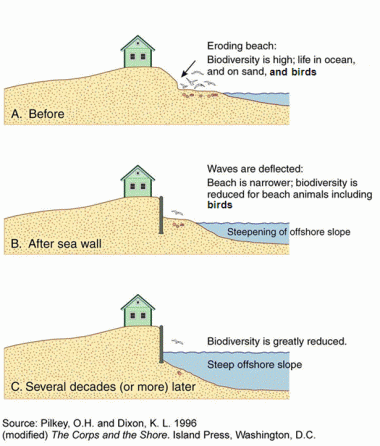The Facts About Shore Protect Team Revealed
Wiki Article
Not known Details About Shore Protect Team
Table of ContentsFascination About Shore Protect TeamThings about Shore Protect TeamShore Protect Team Fundamentals ExplainedThe 6-Second Trick For Shore Protect TeamAn Unbiased View of Shore Protect TeamLittle Known Questions About Shore Protect Team.The Best Strategy To Use For Shore Protect Team
Decline in building worth: As the area tourism is affected by disintegration, so then is the economic climate. Customers are less most likely to look for a coastline house that can be destroyed at any moment by the approaching flooding and disintegration emergency situation. Subsequently, residential property value can drop greatly and influence the entire region.Whether a coastline is simply tiny and congested or has to shut completely for the safety of the ecosystem and neighboring buildings, this substantially influences tourist. Subsequently, local economic situations are affected (https://www.craigslistdirectory.net/Shore-Protect-Team_434857.html). Threat of injury: The enhanced danger of flooding and structural failings causes a boosted risk of injury to neighboring tourists and neighborhood participants

Shoreline stabilization is straight related to their work. Waterfront hotels: Because coastline disintegration effects tourist, it affects the success of beachfront resorts.
Examine This Report on Shore Protect Team
Coastal business organizations: No visitors implies no business. Coastal state parks: State parks that exist along shorelines are at danger of damages.Soft stabilization is a much far better remedy for the environment and more sustainable overall. Difficult stablizing makes use of man-made frameworks as defense to manage disintegration. Normally, these frameworks are mounted at best angles or alongside stop sand activity and minimize the pressure of waves. Many types of hard stablizing like seawalls and sheet metal are not suitable for shoreline stabilization.
Unknown Facts About Shore Protect Team
There's also not nearly enough evidence of their performance depending on the kind of coastline and neighborhood conditions. Hard stabilization strategies often tend to be extra challenging to install and don't match the natural aesthetic, protruding like a sore thumb and harming regional environments in numerous scenarios. Beach sustenance is the process of adding lost sand and sediment back to coastlines after disintegration has actually happened.TrapBags aid in the procedure of coastline nutrition by securing all-natural communities and permitting plants to expand. While this process can be expensive and is not irreversible, the pros often tend to surpass the disadvantages. TrapBag barriers deal numerous homes that make them perfect for seaside and riverbank disintegration protection. They're: Eco-friendly: You can use indigenous dirt both to surround and to fill up the TrapBags.

About Shore Protect Team
Easy to install: Alleviate of installment suggests TrapBags can be released swiftly in case of an emergency. They can likewise be set up with no heavy equipment. Affordable: TrapBags are optimal for both tiny and huge areas of shoreline. They offer an economical solution to cover tasks of any type of dimension.The ideal seawall layout relies on location-specific aspects, including bordering erosion procedures. There are three main kinds of seawalls: vertical, bent, stepped, and mounds (see table listed below).
All-natural obstacles, such as coral reefs and mangrove forests, avoid the spread of tidal waves and the flow of seaside waters and alleviated the flooding and rise of water. A cost-benefit method is an efficient means to determine whether a seawall is proper and whether the benefits deserve the cost.
The Single Strategy To Use For Shore Protect Team
A seawall is a static feature which can clash with the dynamic nature of the coast and restrain the exchange of debris in between land and sea. Benefits and disadvantages of seawalls according to Short (1999) Advantages Negative aspects Lengthy term service in contrast to soft coastline nourishment (https://orcid.org/0009-0005-5137-957X).
This can create beaches to dissipate, making them worthless for beach goers. Typically, seawalls can be an effective means to regulate coastal disintegration, but just if they are created well and out of materials that can hold up against the force of ongoing wave energy.
Getting My Shore Protect Team To Work
The proper seawall layout depends on location-specific aspects, consisting of bordering disintegration processes. There are 3 main types of seawalls: upright, curved, stepped, and piles (see table listed below).All-natural barriers, such as coral reefs and mangrove woodlands, protect against the spread of tsunamis and the flow of seaside waters and alleviated the flood and rise of water. A cost-benefit method is a reliable way to identify whether a seawall is proper and whether the benefits deserve the expenditure.
3 Easy Facts About Shore Protect Team Described
A seawall is a static attribute which can clash with the dynamic nature of the coastline and hamper the exchange of debris in between land and sea. The table listed below summarizes some favorable and unfavorable effects of seawalls which can be used when contrasting their efficiency with various other seaside administration options, such as coastline sustenance. [] Benefits and downsides of seawalls according to Short (1999) Advantages Negative aspects Long-term remedy in comparison to soft coastline nutrients. bulkhead contractors near.
This can cause coastlines to dissipate, making them useless for coastline goers. Typically, seawalls can be an effective way to regulate coastal disintegration, however just if they are constructed well and out of products that can hold up against the pressure of continuous wave energy. Some understanding is needed of the seaside procedures and morphodynamics certain to the seawall location.
Report this wiki page